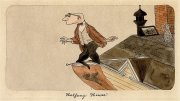The Harvard Film Archive screens the complete works of this year’s McMillan-Stewart Fellow, filmmaker Rosine Mbakam (January 27-February 9). Born in Cameroon and based in Belgium, Mbakam will be on hand February 8 and 9 to discuss her documentaries, shorts, and her latest feature, Mambar Pierrette (2023), which follows a Cameroonian seamstress and single mother struggling to keep her life afloat. Mbakam’s works reflect timeless recurring themes inherent to women’s lives, intergenerational shifts, and the immigration experience. The Two Faces of a Bamiléké Woman (2016) documents her own return trip to Cameroon after a seven-year absence, while Delphine’s Prayers (2021) offers an intimate portrait of a Cameroonian sex worker and her efforts to face, and transcend, daily challenges. You Will Be My Ally, Prism, and Chez Jolie Coiffure will also be screened. (For further details, visit the Harvard Film Archive.)









